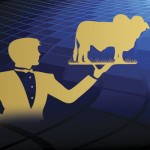
Bill Hodge of Sustainable Genetics says it best:
We believe, first and foremost, that a bovine animal was put on this earth to function as a grazing animal. The further we deviate from the “grazing principal”, the more problems we create. Unfortunately the industrial agricultural model has created a “fossil fuel” dependent machine and totally ignored Mother Nature’s original purpose for this “solar powered” creature. There are two types of cattle today, “corn cattle” and “grass cattle”. Our many years experience has taught us that “grass cattle” will work in a corn environment, however “corn cattle” in a forage environment is not sustainable.
The “seedstock” industry continues on a collision course with reality. The “more, bigger, better” mentality of the majority of purebred cattle owners is creating animals the commercial sector cannot maintain. The advent of Expected Progeny Difference’s has made it quite easy to breed cattle. The only tools necessary are a sire summary and a checkbook. What most seedstock owners fail to understand is EPD’s are only measures of outputs and the antagonisms associated with selecting for extremes create problems that usually end up in the commercial sector.
The most obvious economic objective of any beef cattle breeding program is to maximize profit from available resources. Another related objective would be to maximize feed conversion efficiency. Due to the cost of feed representing such a major expense in producing beef cattle, any improvement in feed conversion efficiency would result in major decreases in costs and an increase in profitability. Providing feed to beef animals is a major cost and has long been recognized by the poultry and pork industries where feed costs are easily quantified. These industries have made great improvements in feed efficiency through genetic and non-genetic means. The cost of providing feed is more difficult to quantify in grazing systems. It includes the capital cost of land, costs of pasture improvement, irrigation, supplementary feed, operating and capital cost of plant, machinery and labor.
Traditionally, beef producers have improved their herds by selection for growth. Growth is an easy and economical trait to measure and is moderately heritable. Selection for growth traits has resulted in faster growing cattle, however it has also resulted in the introduction of some correlated undesirable traits such as increased birth weights leading to calving difficulties, delayed sexual maturity and increased herd maintenance requirements associated with the feed costs of larger animals. Selecting to improve the efficiency of feed conversion in a herd has been proposed as an alternative to selecting for growth rate. Here the producer is striving to improve the efficiency of converting feed to gain, rather than concentrating on growth alone.
Brahman seed stock producers must generate genetics under commercial conditions and always keep in mind commercial cattle producers needs. Commercial cattle producers are seeking high net profit and cannot afford high input systems. They are basically a forage-based system and in order to be profitable, their cattle must perform economically.
Many purebred breeders have concentrated on popular numbers and EPD’s which are not generated under commercial conditions. High input systems will not work in the commercial segment of the industry.


